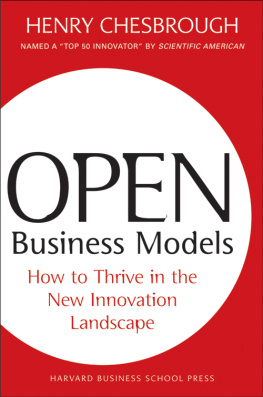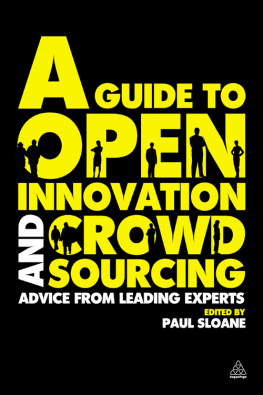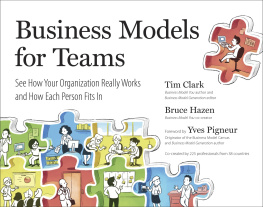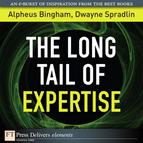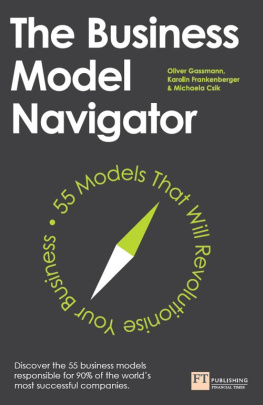No part of this publication may be reproduced, stored in or introduced into a retrieval system, or transmitted, in any form, or by any means (electronic, mechanical, photocopying, recording, or otherwise), without the prior permission of the publisher. Requests for permission should be directed to , or mailed to Permissions, Harvard Business School Publishing, 60 Harvard Way, Boston, Massachusetts 02163.

Why Business Models
Need to Open Up
F ormer baseball catcher Yogi Berra liked to observe that the future isnt what it used to be. This same general pessimismhas been voiced about innovation in the United States and Europe, even as the innovation opportunities globally in placessuch as China and India have greatly expanded.
And it is not hard to see why. The great research and development laboratories of the twentieth century have been downsized,broken up, or redirected to new purposes in the West, while new labs are springing up overseas in large countries such asIndia and China, as well as small countries such as Finland and Israel. Companies are shortening their time horizons for researchand development expenses and are shifting money from R to D. Many great universities are putting up patent fences aroundnew research discoveries that are funded by taxpayer dollars. Start-up companies once were the great hope that would fillthe void in corporate innovation, but the bust in the Internet sector and the venture capital market has dampened these expectations.Fears of outsourcing high-wage jobs to low-cost centers around the world dominate many discussions of economic and trade policy.In many varied parts of the western innovation system, the future of innovation has clearly changed.
Even the rapid emergence of India and China into the international economic system does not assuage these concerns. Transferringinnovative activities to more efficient regions saves money in the short run but by itself may not do much to increase thenumber of new ideas that are needed to advance technology and improve our standard of living in the long run. Where will thecritical breakthrough ideas of the twenty-first century come from? These changes raise concerns about the ability of advancedeconomies to continue to innovate at the pace of the last century.
But hidden among these worrisome trends are other developments that are perhaps more hopeful for the future of innovation.One such development is the growing division of innovation labor. By a division of innovation labor, I mean a system whereone party develops a novel idea but does not carry this idea to market itself. Instead, that party partners with or sellsthe idea to another party, and this latter party carries the idea to market. This new division of labor is driving a new organizationalmodel of innovation, one that may offer more hopeful prospects for innovation in the future.
To tap into this new division of labor, companies will have to open up their business models. If they are able to do so, manymore ideas will become available to them for consideration, and many more pathways for unused internal ideas will emerge tounlock latent economic potential as those ideas go to market. Companies that effectively build or change to open businessmodels to exploit these opportunities are likely to prosper.
Lets be clear about what is meant by an open business model. A business model performs two important functions: it creates value, and it captures a portion of that value. It createsvalue by defining a series of activities from raw materials through to the final consumer that will yield a new product orservice with value being added throughout the various activities. The business model captures value by establishing a uniqueresource, asset, or position within that series of activities, where the firm enjoys a competitive advantage.
An open business model uses this new division of innovation laborboth in the creation of value and in the capture of a portionof that value. Open models create value by leveraging many more ideas, due to their inclusion of a variety of external concepts.Open models can also enable greater value capture, by using a key asset, resource, or position not only in the companys own businessbut also in other companies businesses.
To understand the attractive potential of this new approach to innovation, and the role of an open business model, considerthe following names and what they may have in common:
Qualcomm, a maker of cellular phone technology
Genzyme, a biotechnology company
Procter & Gamble, a consumer products company
Chicago, the musical stage show and movie
This assortment of companies and products might strike you as random, but all share a common characteristic: each startedwith an idea that traveled from invention to market through at least two different companies, which divided the work of innovationbetween them. Qualcomm, for example, used to make its own cell phones and base stations but stopped doing that years ago. Others make those products now. Today, Qualcomm makes chips and sells licenses to its technologies, period. Every phone usingits technology is sold by a customer of Qualcomm, not the company itself.
Genzyme has achieved its success by licensing technology in from outside the company and then developing that technology furtherwithin the company. It has developed these external ideas into an array of novel therapies that deliver important cures forpreviously untreatable, rare diseases. It has also built a record of impressive sales and profits in an industry where profitshave been hard to obtain.
Procter & Gamble (P&G) has rejuvenated its growth through a very successful program called Connect and Develop, which licensesin or acquires products from other companies (such as the SpinBrush, Olay Regenerist, and the Swiffer) and takes those productsto market as P&G brands. The company now actively seeks external ideas and technologies through an extensive network of scouts.
Chicago, the often-revived musical stage production, emerged out of a creative extension of a play written long ago, which was outof print. multiple times to become a prize-winning show. And each time the show was revived, it was done by a different owner! Themost recent revival, in 1997, turned into an Academy Awardwinning movie in 2002 and even created a best-selling musical soundtrackin the process.
There is something else that these diverse items all share: all were assisted by the astute management of an open businessmodel. These items changed hands at least once in their journey to the market: they were bought, sold, licensed, or otherwisetransferred from one party to another. Without a business model that sought to harness these external parties (and withoutthe effective management of intellectual property to work with them), the resulting innovations may never have seen the lightof day.
If these ideas were so valuable, an obvious question arises: why didnt the original owners of them figure out the best wayto use them and take them to market? The answer goes to the very heart of what is important about intermediate markets forinnovation. Different companies possess different assets, resources, and positions, and each has a different history. These differences cause companies to look at opportunities differently. Companies will quickly recognize ideas that fit thepattern that has proved successful for them before. But they will struggle with ideas that require a very different configurationof assets, resources, and positions to be successful. With intermediate markets, ideas can flow out of places where they donot fit and find homes in companies where they fit better. So lets examine these intermediate markets.

